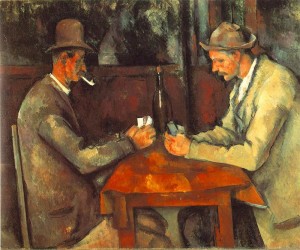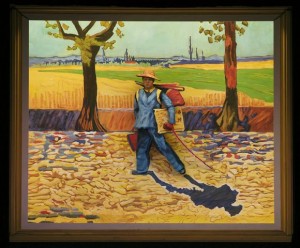I seem to recall tales of my favourite artists, like Van Gogh or Monet, spending much of their time in cafes and bars, with a glass of absinthe or a bottle of wine. Of course the truth must have been quite different, the sheer volume of their work output, means they had to spend their days in the fields, by the riverside or in public spaces, painting as often as the weather and light would allow, and then when you add in all the studio and interior subjects they produced, it doesn’t seem to leave much time for idling.

And if you need proof, here is Paul Cezanne’s Card Players. Of course, that means Cezanne was actually working while others, played cards. Cezanne painted several more works in this genre all with similar models or characters. In addition he probably drew some tonal sketches, to help decide on the composition and where to place the various elements, including the light source and the shadow areas.
Artists, like anyone today who tries to earn a living by creating something worthwhile from just their imagination and surroundings, need to plan their days just like the impressionists did. Things haven’t changed much over the years.
While we’re on the subject of changes, easier travel and computers have made life for today’s artists easier, in many respects. One of my favourite Van Gogh paintings was lost in the war, and it shows an artist, probably Van Gogh, ‘On the road to Tarascon’, carrying his canvases easel and bags, looking for the ‘right’ view to paint.
When my wife and I visited Avignon recently, we were just a short distance from Tarascon, which sits between Avignon and Arles to the south, and in the heat of summer, it was not difficult to imagine the scene.
The Van Gogh Museum in Amsterdam confirmed the loss of this work in WW2, but they didn’t say how. I have recently learned that it was destroyed by fire in a German Art Gallery near the end of the war.
What a shame, a Dutch artist, painting a French scene, destroyed by British or American action in Germany. Maybe I should now stop checking the local auction rooms for it?
I’m glad that travel is easier these days, I wouldn’t want to have to carry that lot, for miles on foot. The computer of course is most welcome and convenient, but now artists have to write blogs and plan exhibitions themselves, rather than rely on an agent or gallery.
What do you think life was like for an artist in the late 19th Century? Your views or ideas would be interesting to read.

